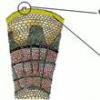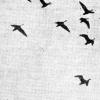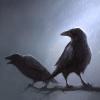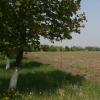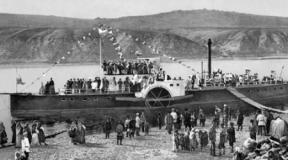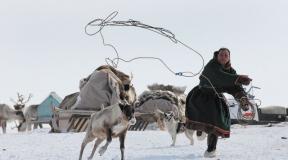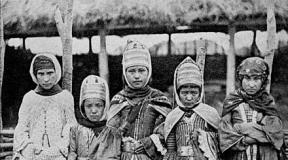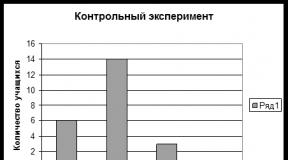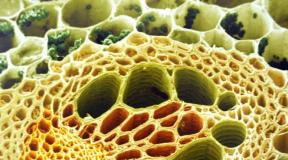Nenets activities. The main occupations and means of transportation of the Nenets. They turn over the tea cups
Customs and holidays of Dolgans.
“The Dolgans have such a custom...”
The famous Dolgan poetess Ogdo Aksenova wrote the following lines: “The Dolgans have a custom - to share the first booty. Remember, boy! In former times, the Dolgans always gave part of the meat of wild deer and caught fish to relatives and neighbors. But the furs were not subject to division. She was valuable. goods, in exchange for which one could get guns, gunpowder, tea, flour, sugar from visiting traders.
Traps for arctic foxes - in Siberia and the Far North they are often called “graze” - were the personal property of each hunter. Only the person to whom these traps belonged could check the mouths and take away the animals caught in them. There was another important rule related to arctic fox hunting. If you decide to set your traps further south than those set by another hunter, you do not need his permission to do so. But if you want to place the traps north of other people’s traps, you must obtain the consent of their owner. Why did such a custom arise? Everything is explained very simply: arctic foxes come to the lands of the Dolgans from the north, and therefore the hunter whose traps are located to the north has a greater chance of success.
The little mistress of the big plague
Dolgans until the 19th century. retained the remnants of matriarchy, although their kinship was maintained through the male line. Women maintained the fire, “fed” it; they were in charge of all household shrines. In winter, several Dolgan families, as a rule, united and built a large tent from inclined wooden blocks, lined with turf for warmth. The inhabitants of the winter house chose a common mistress. Often it was an elderly woman, hunched over from hard work. The word of the little mistress was law for everyone, including the proud and warlike Dolgan men.
Customs and holidays of the Khanty and Mansi
The Khanty and Mansi, two Finno-Ugric peoples closely related in language and culture, live in the north of Western Siberia - in the Tyumen, Tomsk and Sverdlovsk regions. They are often united under the general name “Ob Ugrians”, since they are settled along the Ob River and its tributaries. The Khanty and Mansi are engaged in hunting and fishing, and part of the population is reindeer herders. The Khanty and Mansi lived sedentary lives along the rivers or made small movements throughout the year. Their holidays and rituals reflected the rich experience of man's exploration of northern nature.
Customs related to attitudes towards nature
Prohibitions play a big role in the life of the Khanty and Mansi. This is especially evident in relation to the earth, which cannot even be injured by a sharp object. There were separate plots of land, the banks of some lakes and rivers, on which it was forbidden to walk. As a last resort, it was necessary to tie birch bark to the soles. Passing or driving past such places, the Khanty and Mansi perform certain rituals - they make a sacrifice (food, butts made of cloth, etc.). The Khanty and Mansi performed sacrificial rituals at the beginning of a trade, such as fishing or hunting. During such sacrifices, they turned to the spirits - the owners of certain places with a request to give more prey in the coming season.
Raven day
The crow is one of the first to fly to the North, in April, when there is still snow and frosts. With her cry, she seems to awaken nature and, it seems, brings life itself. This is probably why the Khanty and Mansi consider this bird the patroness of women and children and dedicate a special holiday to it.
In a crow song recorded on the Northern Sosva River, there are these words: “With my appearance, let little girls, little boys be born! I will sit down on a hole with melted rotten things (from their cradles). I will warm my frozen hands, I will warm my frozen feet. Let girls be born who live long, let boys who live long be born!” According to the customs of the Khanty and Mansi, all the belongings of small children must be strictly monitored so that no misfortune happens to the child. This also applies to those items that the baby no longer needs. Therefore, rotten shavings - shavings of soft wood, which were poured into the cradle instead of diapers, were folded after use in a secluded place. The Khanty believed that a crow, having flown from the south, warms its paws on these warm shavings on cold days and says: “If only more children would come to earth, so that I have somewhere to warm my paws.” Previously, only elderly women and girls gathered for the holiday. They prepared treats, among which there was always a thick porridge-scramble “salamat”. Dancing was an indispensable element of the holiday. Some groups of Khanty and Mansi associated this holiday with the ancestral goddess Kaltashch, who determined the destinies of people, marking their life path on sacred tags, and helped during childbirth. At women's festivals held in certain places, scraps of fabric were often tied to a tree. The purpose of such holidays was the pursuit of well-being, first of all, caring for children.
Bear holiday
This is the most favorite holiday of the Khanty and Mansi. The bear is considered the son of the supreme deity Torum, at the same time he is the son of the female ancestor and the brother of her children, therefore the Khanty and Mansi perceive him as a brother. And finally, he is the personification of supreme justice, the owner of the taiga. Every successful bear hunt is accompanied by a holiday, where people try to relieve themselves of the blame for killing it and perform rituals that should lead to the well-being of all participants in the holiday. The bear's skin was rolled up, the head and paws were decorated with rings, ribbons, scarves and placed in the front corner of the house in the so-called sacrificial pose, with the head placed between the outstretched front paws. Then they staged performances wearing masks. In the first half of the night, dances dedicated to the main gods are performed. The middle of the night and its second half were of particular importance, when they ate bear meat, escorted the soul of the bear to heaven, and wondered about the upcoming hunt.
Customs and holidays of the Nenets, Selkups, Entsy and Nganasans
These peoples have a lot in common. The languages of the Nenets and Selkups, Nganasans and Enets belong to one - the Samoyed group of the Ural-Yukaghir language family. Samoyeds live next door, sometimes in the same villages. Their traditional activities are similar: everyone is engaged in reindeer herding, hunting, and fishing. The number of Samoyed peoples varies: Nenets - about 35 thousand, Selkups - 3.5 thousand, Nganasan 1.3 thousand and Entsy only 200 people.
Deer veneration ritual
Among the Samoyeds, veneration of various animals, birds, and fish was widespread. But, perhaps, no animal was held in such esteem as the deer. This is explained by the special role of deer in the life of the Samoyed tribes. For the Nganasans, wild deer was the main object of hunting. It was usually obtained in the fall, at water crossings, when reindeer herds moved from the Taimyr tundra to the south, into the Evenki taiga. The Enets also hunted wild deer, but in a different way than the Nganasans. They were helped in this by specially trained domestic reindeer decoys. These deer, with their antlers bound in straps, were allowed near their wild counterparts. Wild deer got into fights with uninvited guests and got tangled in their belts with their antlers.
The cult of deer was especially developed among the Nenets, hereditary reindeer herders, owners of the largest reindeer herds in the Samoyed world. According to ancient Nenets customs, white deer were considered sacred. They were not harnessed to sledges or slaughtered for meat. The antlers and ears of white deer were decorated with red ribbons, and the sign of the sun or the image of the spirit of fire was cut on the sides. White deer were considered to belong to Num, the supreme deity who, according to the Samoyeds, created the earth and everyone who inhabits it.
Ritual of reviving a tambourine, or riding a deer for the clouds
An interesting custom associated with the veneration of deer existed in ancient times among the Selkups. In accordance with a long-standing tradition, it was believed that the shaman’s tambourine was a deer, on which the mediator between people and spirits made trips to heaven. However, before setting off, the shaman had to “revive” the tambourine. This ritual was performed in the spring, when the birds arrived. The time for the ceremony was not chosen by chance. The Selkups considered birds to be their closest relatives and often called themselves eagle or grouse people. The ceremony of reviving the tambourine lasted ten days. Its culmination was the shaman reaching the land “where seven suns shine, where the stone reaches the sky.” Depicting his stay in this magical land, the shaman showed the audience that he was very hot, that sweat was pouring from him in streams. The ritual of reviving the tambourine ended with a general feast and feeding of idols, the wooden figurines of which the Selkups considered to be the personification of their ancestors.
According to many ethnographers, the idea of a hot mountainous country, where the shaman found himself on his animated deer tambourine, arose among the Selkups because the Samoyed tribes came to the North from the southern regions of Siberia, from the Sayan-Altai Highlands. In other words, in ancient times the Samoyeds really lived where there was a lot of sun and “the stone reached the sky.”
Holiday of pure plague
One of the main holidays of the Samoyed peoples was associated with the end of the polar night. It was celebrated at the end of January - beginning of February, when the winter sun, after a long absence, reappeared in the sky. This holiday was celebrated very solemnly by the northernmost of the Samoyeds - the Nganasans, who live far beyond the Arctic Circle. For the holiday, a special, “pure tent” was set up, in which the shaman performed continuous rituals for several days. While the shaman’s tambourine sounded, young people gathered near the “pure plague”, performed ancient dances, and organized games. It was believed that all these actions should ensure good luck in the coming year. Sometimes the holiday took place differently. Instead of a “pure plague”, “stone gates” were built. They were something like a tunnel. The shaman’s rituals continued for three days next to the tunnel, and then he and after him all the inhabitants of the camp passed through the stone gate three times.
Evenki customs and holidays
The famous Norwegian Arctic explorer Fridtjof Nansen called the Evenks “Indians of Siberia.” Indeed, these indigenous inhabitants of North Asia have many similarities with the famous hunters from the Iroquois or Delaware tribes. Like the North American Indians, the Evenks are hereditary hunters, skilled trackers, and tireless travelers. Their number is just over 30 thousand people. But the Evenks are settled over a vast territory - from Western Siberia to Yakutia, Buryatia, and Primorye. The Evenki language belongs to the Tungus-Manchu branch of the Altai language family. In the recent past, the Evenks were called Tungus.
How guests were received
The custom of hospitality is known to all peoples of the world. It was strictly observed by the Evenks as well. Many Evenk families had to roam the taiga for a significant part of the year, separated from other families, so the arrival of guests was always a holiday. Guests were given gifts, seated in a place of honor in the tent (behind the fireplace, opposite the entrance), and treated to the most delicious dishes, for example, finely chopped bear meat, seasoned with fried bear fat. In the warm season, dances were held in honor of the arrival of guests. They danced in a clearing, not far from the camp. Traditional Evenki dances were unusually temperamental. All the inhabitants of the camp took part in them - from young to old.
After a plentiful meal, exchange of news, dancing, when the day was approaching evening, one of the guests or hosts began a leisurely story. The narrator alternated between speaking and singing, and the listeners repeated the most important words in chorus. The heroes of the story could be people, animals, powerful spirits. Such, for example, as “Old Man Amaka”, in whose hands “are the threads of our lives”, or the heavenly hunter Manga, who defeated the magical moose Bugada and returned to people the sun stolen by the moose...
All night in the tent where guests were received, people did not close their eyes: the tales were so long that, as a rule, they did not have time to finish them by dawn. The guests remained in the camp for one more day.
How peace was made
The Evenks valued the ability not only to fight, but also to negotiate peace. First, a detachment led by a shaman approached the enemy camp and warned with a loud cry of its approach. The enemy sent envoys - two elderly women. The straps of their high fur boots (fur boots) must be untied. This is a sign that the parliamentarians are ready to negotiate. Older women, representing the hostile side, enter into conversation with older women. The shaman pointedly rejected the proposals and ordered to prepare for battle. Then the defenders sent two elderly men with untied straps of their high boots. New negotiations began, which were now conducted among the oldest men. However, this time an agreement cannot be reached either: the shaman sends the envoys back. Then a shaman from the defending camp arrives at the attacking camp. Both shamans sit with their backs to each other, on either side of swords stuck crosswise into the ground, and speak directly. Such a conversation ends with the conclusion of peace. The ritual, which included multi-stage negotiations, was intended to create a certain mental mood in people, to demonstrate to everyone how difficult it is to make peace and how important it is to protect it in the future.
Customs and holidays of the Koryaks
“Reindeer people” - this is how the word “Koryak” is translated into Russian - live in Kamchatka, Chukotka and the Magadan region. There are about 10 thousand of them. Hunting equipment, myths, rituals, and holidays of the Koryaks have much in common with the traditions of the inhabitants of Alaska. The famous ethnographer V.I. Yochelson put forward a hypothesis according to which the “reindeer people” came to the Far East from America. Modern researchers do not deny the similarity of the Koryaks with the Indians, but they explain it differently: both had common ancestors - ancient hunters of Siberia.
Meeting and seeing off the beast
Many Koryak customs and holidays were based on the ancient myth of a dying and resurrecting beast. When the hunter returned with his prey, the inhabitants of the camp hurried to meet him to solemnly greet the “guest” - a bear, a seal, a fox. The women held burning brands in their hands. For a long time among the Koryaks this was a sign of special respect for the guest. One of the ritual participants put on an animal skin and performed an ancient dance. While dancing, she asked the beast “not to be angry and be kind to people.” The inhabitants of the dwelling where the hunter lived prepared a festive treat and offered it to the “guest”. If the prey was a bear, a domestic deer was slaughtered in its honor.
It was important not only to greet the animal well, but also to “see it off” home with honor. This is how the “seeing-off of the bear” took place among one of the Koryak tribes. The inhabitants of the camp reenacted a hunting scene. One of them, wearing a bear skin over his shoulders, depicted a bear. At first, he fought with the hunters, and then stopped fighting, took the bag of gifts prepared for him, and in return gave his skin to the people... For many decades, the Koryaks strictly ensured that all their fellow tribesmen performed the ritual of welcoming and seeing off the beast, since it was from This, in their deep conviction, depended on the return to life of animals killed during the hunt.
Celebration of the return of the sun
The Koryaks celebrated this holiday at the end of December, after the winter solstice, when the length of daylight began to increase. On the eve of the holiday, reindeer herders necessarily migrated and established a camp in a new place. Then they waited for the guests to arrive. These were inhabitants of other reindeer herding camps, as well as residents of coastal villages and sea hunters. The holiday began early in the morning. Women, using a wooden flint in the shape of a human figurine, lit a fire. The men were killing deer. It was believed that they were sacrificed to “the one above” - the sun. The head of the largest sacrificial deer was put on a pole and turned to the east. Flint was “fed” with the blood of deer, and all participants in the holiday were treated to meat. After a hearty meal, which was accompanied by singing and dancing, sports competitions began. The main one was reindeer sled racing.
Customs and holidays of the Chukchi
The Chukchi - today their number is just over 15 thousand people - inhabit the extreme northeast of Russia, Chukotka. The name of this distant Arctic region means “land of the Chukchi.” The Russian word “Chukchi” comes from the Chukchi “chauchu” - “rich deer”. The Chukchi have a thousand-year history. Their distant ancestors came to the Arctic from the central regions of Siberia, when in place of the Bering Strait there was a vast isthmus connecting Asia and America. Thus, some residents of Northeast Asia crossed the Bering Bridge to Alaska. In the traditional culture, customs and holidays of the Chukchi, there are features that bring them closer to the Indian peoples of North America.
Kaydara holiday
According to the ancient ideas of the Chukchi, everything that surrounds a person has a soul. The sea has a soul, and so does the canoe, a boat covered with walrus skin, on which even today arctic sea hunters fearlessly go out into the ocean. Until recently, every spring, in order for the sea to accept the canoe, hunters organized a special holiday. It began with the boat being solemnly removed from the pillars made of the jaw bones of the bowhead whale, on which it had been stored during the long Chukchi winter. Then they made a sacrifice to the sea: pieces of boiled meat were thrown into the water. The baidara was brought to the yaranga - the traditional dwelling of the Chukchi - and all participants in the holiday walked around the yaranga. The oldest woman in the family went first, then the owner of the canoe, the helmsman, the rowers, and the rest of the participants in the holiday. The next day, the boat was carried to the shore, a sacrifice was made to the sea again, and only after that the canoe was launched into the water.
Whale Festival
At the end of the fishing season, late autumn or early winter, the coastal Chukchi held a whale festival. It was based on a ritual of reconciliation between hunters and killed animals. People dressed in festive clothes, including special waterproof raincoats made of walrus intestines, asked for forgiveness from whales, seals, and walruses. “It wasn’t the hunters who killed you! The stones rolled down the mountain and killed you!” - the Chukchi women sang, addressing the whales. The men staged wrestling matches and performed dances that reenacted scenes of hunting sea animals full of mortal danger.
At the whale festival, sacrifices were certainly made to Keretkun, the owner of all sea animals. After all, the residents of Chukotka believed that success in hunting depended on him. In the yaranga where the holiday took place, a Keretkun net woven from deer tendons was hung, and figures of animals and birds carved from bone and wood were installed. One of the wooden sculptures depicted the owner of sea animals himself. The culmination of the holiday was the lowering of whale bones into the sea. In sea water, the Chukchi believed, the bones would turn into new animals, and the next year whales would appear off the coast of Chukotka again.
Festival of the Young Deer (Kilvey)
Just as solemnly as the coastal inhabitants celebrated the whale festival, Kilvey, the festival of the young deer, was celebrated on the continental tundra. It was held in the spring, during calving. The holiday began with the shepherds driving the flock to the yarangas, and the women laying out a sacred fire. Fire for such a fire was produced only by friction, as people did many hundreds of years ago. Deer were greeted with loud cries and gunshots to scare away evil spirits. Tambourines-yarars, which were played alternately by men and women, also served this purpose. Residents of coastal villages often took part in the festival together with reindeer herders. They were invited to Kilway in advance, and the more prosperous the family was, the more guests came to the holiday. In exchange for their gifts, residents of coastal villages received deer skins and venison, which was considered a delicacy among them. At the festival of the young deer, they not only had fun on the occasion of the birth of the fawns, but also performed important work: they separated the important ones with their calves from the main part of the herd in order to graze them on the most abundant pastures. During the holiday, some of the adult deer were slaughtered. This was done in order to prepare meat for future use for women, old people and children. The fact is that after Kilvey, the inhabitants of the camp were divided into two groups. Elderly people, women, and children remained in winter camps, where they fished and picked berries in the summer. And the men set off with the reindeer herds on long journeys to summer camps. Summer pastures were located north of the winter nomads, not far from the coasts of the polar seas. A long journey with a herd was difficult, often dangerous. So the holiday of the young deer is also a farewell before a long separation.
Customs and holidays of the Eskimos
The people we call Eskimos live on the Chukotka Peninsula. This is the extreme northeast of the Asian part of Russia. There are only 1,700 Eskimos there. However, this is not the whole people, but only a small part of it, because Eskimos also live in the USA, Canada and on the island of Greenland. This nation numbers more than 100 thousand people in the world. Eskimos are sea hunters and hunters. They hunt whales, walruses, seals, seals and feed on the meat of these animals. The Eskimos call themselves Inuit, which means “real people.”
Celebration of the beginning of spring hunting (Atygak)
Sometimes this holiday is called differently - “the holiday of launching a canoe.” It is arranged in late spring - early summer. It is at this time that the hunting season for sea animals begins. The family that has a canoe (and not all of them have them) lowers it to the sea with the help of relatives and neighbors. A baydara is a light, fast boat. It is a wooden frame covered with walrus skin. A large canoe could fit up to 25 people. It is in a canoe that a group of hunters will go hunting. While the men are busy with the boat, the women prepare the food: boil the meat, make something like cutlets from meat, lard and seal fat, as well as a special dish from roots and herbs collected in the summer. And then all the adult family members - men and women - begin to paint their faces with black graphite or soot, drawing several lines along the nose, on the chin, under the eyes. This is not just a decoration, it is a magical ritual. The number of these lines is directly related to the sea animal that this family believes brings them happiness - the walrus, seal, whale, seal. Then everyone puts on festive white clothes. In the old days, these were special clothes made from the intestines of sea animals. Then everyone goes to the seashore, bringing the prepared food with them. The owner of the canoe cuts the brought meat into small pieces and throws them into the sea and into the air. This is a sacrifice to the spirits of the wind and the owner of sea animals. Luck in the hunt depends on them. Some of the meat is thrown immediately into a lit fire - this is a sacrifice to the spirit of fire.
Walrus Festival (Naskunikhkylyk)
The walrus hunt usually ended at the end of July. A period of stormy weather was beginning, and sea hunters did not risk going far from the coast in their canoes to hunt for walruses. Then it was time for another holiday. On the day of the holiday, a walrus carcass was taken out of the glacier. The owner of the yurt or the shaman invited by him began to beat the tambourine, calling for a treat various spirits on which a person’s life, health and hunting success depend. The owner took some of the prepared food to the seashore, threw it in small pieces into the air and into the water with the words: “Get together here and eat!”
After the meat was divided among relatives, the walrus skull was taken to a special rock - a sacrificial place for the “mistress of sea animals.” As during the holiday of the beginning of the spring hunt, all families take turns walking, but each invites all residents of the village.
Whale Festival (Fields)
The whale is the main game animal of the Eskimos, the most dangerous from the point of view of hunting it and the most desirable, because the whale is a lot of meat and fat. The entire village can feed on them at once, and can be stocked up for future use for a long time. The holiday is organized by the one who killed (harpooned) the whale. All the residents of the village gather to see him. The whale is butchered right on the shore and eaten immediately. During the holiday, images of whales are made - wooden sculptures - which are hung in different corners of the yaranga. The festival uses finely crushed graphite, which, when thrown into the air, magically reproduces the fountain released by a whale swimming in the ocean. At the whale festival, as usual, the whole village walks. Many families keep amulets with the image of a whale. In honor of the whale, a special dance is performed, reproducing all stages of the hunt for it. It is curious that this dance is performed by all participants sitting in one place: only the arms and head move.
The Nenets are a Masodic people. Their outdated name is Yuraks or Samoyeds. They inhabit almost the entire coast of the Arctic Ocean. Among all the indigenous peoples of the North of Russia, the Nenets are the most numerous. There are over 40 thousand of them in the country, 27 thousand of them live in the Autonomous Yamalo-Nenets Okrug.
The Nenets are divided into two full-fledged groups: forest and working peoples. The majority are labor related. People belonging to this group settled throughout the tundra zone: from the lowlands of the Yenisei River to the Kola Peninsula. There are only 1,500 forest people. They call themselves “neschang”. They settled between the same Yenisei River and the Ob River, but most of them live near the Pur and Nadym Rivers, as well as in the northern parts of Agan, Lyamin and Tromegan. Differences between groups have been formed for centuries. Mostly they differ from each other along ethnic lines.
The Nenets inhabit almost the entire coast of the Arctic Ocean // Photo: agenda-u.org
Historical reference
Like the rest of the Northern Samoyedic peoples, this people was formed thanks to several ethnic components. Initially, the Nenets lived in the taiga of the Middle Ob region, near the Tobol region and the Irtysh region (in their forest zones). However, during the 1st millennium the Turks and Huns exerted significant pressure on them. The Nenets were forced to leave their settled places and move north closer to the tundra and taiga regions of the Subpolar and Arctic regions. They mixed with the aborigines, who were sea hunters and hunters of the deer living nearby. Over time, the Entets and Ugric groups also became part of the people.Over time, their traditional trade became hunting wild deer, fur-bearing animals and waterfowl. Since the 18th century, reindeer herding has become one of the branches of the household economy. With the advent of the Soviet Union, the economy of the indigenous population suffered some changes. Most people began to work in industrial enterprises, as a result they switched to a sedentary way of life. The rest were engaged in grazing and raising reindeer on established individual economic farms. Some families of reindeer herders began to wander, but most eventually settled in the cities of Salekhard, Naryan-Mar and Pechora. People started working in the service and industrial sectors. The growth of the Nenets intelligentsia began to be observed. The rest continued to lead a nomadic lifestyle. Their traditional home was a collapsible tent. In summer its roof was covered with birch bark, and in winter with reindeer skins.

Over time, hunting for wild deer became their traditional trade // Photo: ng72.ru
Traditional lifestyle
Today the main type of occupation of the people is hunting, reindeer herding and fishing. Almost their entire adult life passes side by side with deer. People use these animals as draft power when riding special sleighs, as well as when transporting heavy things. Deer meat is eaten. The skins are used to insulate houses. When fishing, men go out to the ocean in sorcerer boats. In their fishing they use seines and nets woven from willow bast or hemp plants. Some people practice ice fishing: they attract fish with bait and hit them with a spear.The Nenets are jacks of all trades. They always held in high esteem a man who could cope with the duties of a tanner, a rafter and a carpenter. He had to be able to tie a fishing net, make jewelry, and make a sled. People had almost all their own tools. Only saws and axes were purchased from the Russian people. People have always used sleds as the main method of transportation all year round. They were harnessed to several reindeer, which were driven by a trochee - a 5 m long pole, at the end of which there was a bone ball or an iron tip.

Nenets are jacks of all trades // Photo: visitnao.ru
Religion and faith
The traditional religion of the Nenets to this day is paganism. In addition, belief in spirits – animism – was widespread among the population. The main deity was the spirit of the sky Num. He was the patron of weather conditions, he could easily control snow, lightning, storms, etc. In addition, people always revered the spirits of other elements: fire, lake, earth, forest, river, etc. In order to appease them, people sometimes performed sacrifices. Most often, such a victim was a pure white deer. If people wanted to ask the spirit for health and take away the disease, then the dog became the victim. There are even cases where the victim was the person himself. For example, a person who fell out of a boat was not saved so as not to anger the water spirits.Each Nena family had its own patron spirit. He was personified by a figurine carved from wood or stone of an unusual shape. Such a figurine or stone was kept in a special chest and passed down from generation to generation through the male line. The spirit was also passed down through the female line and was called the “old woman-plague.” This spirit consisted of several small traditional elements of clothing.

The traditional religion of the Nenets to this day is paganism // Photo: barrier.marshruty.ru
The Nenets have always firmly believed in the afterlife. They were sure that after his earthly life a person ends up in the world of the dead. There he “lives” in approximately the same way: he hunts, breeds deer and fishes. At the same time, he spent the same amount of time in that world as he spent on earth. The Nenets believed that this world was a mirror image of the earthly one. Allegedly, night and day change places in it, broken things turn out to be whole, and whole ones - vice versa. Therefore, things that were important to him were always placed in the coffin of the deceased, but they were always broken first.
The Nenets are one of the most numerousindigenous peoples of the Russian Far North. They are settled from the Kola Peninsula to Taimyr along the coast of the Arctic Ocean. It is believed that in the first millennium AD. part of the Samoyed tribes - the ancestors of modern Nenets - were forced out of the territory of the Sayan Highlands by the Turks to the north and adapted to life in the Arctic.

The real Nenets are fishermen, hunters, and carpenters, but their main occupation is large-scale reindeer herding.

For a real Nenets, deer is the most important thing in life: it is food, clothing, and a home; Men's winter clothing is made from the skins of five reindeer, and for a chum - a traditional frame dwelling - at least thirty reindeer skins are needed.


Reindeer is also a means of transportation: modern snowmobiles can break down at the most inopportune moment and require fuel, so the good old means of transportation is often used - a reindeer sled.


Reindeer also serves as a kind of currency: for example, the price of one snowmobile starts from 15 deer, and a bride price starts from forty deer.


For a traditional Nenets family, in order to simply survive a year without increasing the number of livestock, a herd of at least five hundred heads is needed.


Nine months a year in the Far North is winter, temperatures can drop to minus 50 degrees Celsius, and summer is usually high humidity, heat, midges and mosquitoes. Despite the short summer and the almost complete absence of raw fruits and vegetables in their diet, the Nenets never suffer from rickets or scurvy: they get all the necessary vitamins by eating raw deer meat and raw fish.

During the short summer, deer feed on lichens, horsetails, willow and birch leaves, berries, and in the fall – also mushrooms. On occasion, deer will not disdain lemmings and bird eggs. In winter, deer extract moss from under snow up to a meter high, digging it out with their hooves. Both female and male reindeer wear antlers; Males shed them in February-March, and females in April, after calving.


It is necessary to wander, or kaslat (in Nenets) with reindeer herds, to drive reindeer to new pastures quite often. Reindeer herders do not have days off; they have to protect the reindeer herds at night from polar wolves and wolverines in snowstorms and severe frosts.

Reindeer can stray from the herd during a snowstorm, and sometimes in the fall, during the rut, domestic females respond to the call of wild males, and then reindeer herders have to search for them for a long time, for two or three days, and not always successfully.

Despite the difficulties of nomadic life in the harsh conditions of the Far North, the Nenets continue the traditions of their ancestors, live all year round in prefabricated tent houses and do not want to exchange such a life for a city one. They are unusually hospitable and very friendly people, since others simply cannot survive in the Arctic. Nenets reindeer herders are ready for any difficulties and trials, because they live in harmony with nature from birth.

Our state does not really help the small peoples of the North. Once upon a time, the Arctic was conquered for its furs, and merchants completely soldered gullible hunters. Now the North is both a storehouse of minerals and the frontier of our country. Traditional reindeer grazing areas are shrinking everywhere: they are crossed by gas and oil pipelines, oil is poisoning rivers and lakes, and heaps of rusty scrap metal are being left behind by the military.

But we must admit that Russia would not have developed the Arctic if we had not adopted from the indigenous peoples, including the Nenets, the experience of surviving in these harsh conditions, and we must remember this. If the pastures disappear, the deer will disappear, which means that the centuries-old way of life and the original culture of the Nenets will be destroyed.

According to statistics, about 42 thousand representatives of indigenous peoples live in the Yamal-Nenets Autonomous Okrug. This is 8% of the total population of the Autonomous Okrug. The most numerous people are the Nenets - almost 30 thousand people, the Khanty - 9.5 thousand and the Selkups - about 2 thousand people. About 40% of the indigenous peoples of Yamal lead a traditional nomadic lifestyle, that’s 16.5 thousand people.
Every nation in the world has its own characteristics, which for them are absolutely normal and ordinary, but are very surprising to an outsider. Nenets culture today is perceived as so exotic that it is hard to believe that in the age of high technology, somewhere in the region, and this is how the word “Yamal” is translated from Nenets, people still live in tents and roam.
In the camps, the ancient traditions of our ancestors are carefully preserved. Guests will still be greeted in any tent according to all the rules of Nenets hospitality. Specialists from the Yamalo-Nenets District Intercontinental Military Complex named after I.S. told Komsomolskaya Pravda - Yamal about them. Shemanovsky.
1. Having arrived at the camp, you need to go around all the plagues and in each of them, according to the rules of hospitality, accept a treat. If the guests did not enter some kind of tent, the owner may be offended.
2. They enter the chum by holding the edges of the chum covering with one hand and, turning over their left or right shoulder (depending on which direction the “door” opens), with the same hand put the edge of the chum covering in its original position. Knocking or pre-shouting “Is anyone in the chum?” not accepted. You can determine this yourself by the smoke from the chimney, by a log or a long pole leaning against the door.
3. The hostess will definitely invite you to a small Nenets table called tol. Kitchen utensils are placed on the high “noram” table.
4. The owner of the chum, seeing your empty cup, will refill your tea until you turn the cup upside down.
5. The male guests are placed for the night from the middle of the chum to the sacred simza pole. Guests - women, on the contrary, are located from the middle to the exit - closer to fresh air, away from soot.
6 . According to tundra etiquette, it is considered a big mistake to call an adult by name; in other cases, it can even be perceived as an insult. Adults are addressed with a word denoting the degree of relationship, by the name of the eldest son or daughter.
7. The Nenets will treat you to stroganina, or they may “break the fish” with a sharp blow on the table. “Kolotushka” is the same frozen fish, for example, muksun or omul. The fragments of the fish, scattered like a crystal vase, are placed on a dish, but for ordinary meals. Stroganina is often prepared for guests and on holidays.
8. The Nenets cannot sing at the table. The sign says: “you will sing everything.”
9. It is not worth helping the hostess clear the table, wash or dry dishes. It is believed that such help from guests can result in failure for the hostess, her table will become poorer, and all good fortune will go to the guest. Neither a man nor a boy should touch the dishes. According to legends, the clinking of dishes will scare all the game and run away.
10. It is not customary for the Nenets to leave before the end of the meal. If guests are in a hurry, the chum hostess must hold on to the edge of the table, otherwise the guests will “carry away” her family’s wealth with them.
11. Building a house is a woman's job. For the construction of houses among the Nenets, only the “weaker sex” is responsible. They are also the owners of tents, which they usually receive as a dowry from their parents. A tundra Nenets family is called myad ter (“me” - chum in Nenets) - which literally means “contents of the plague” - household members.
12. Since ancient times, the hearth circle on the floor of the plague was perceived as the entrance to the underworld. When the tent was dismantled and the hearth leaf was lifted, a stain remained in this place, by which one can recognize that the tent stood here. It is not allowed to place a fire leaf on the same spot a second time; it is believed that this will damage the ground.
13. Nomads always clean up the area after themselves and burn the garbage. It was considered dangerous to leave even a hair or a cut nail at the site of the former plague. Under it, it was believed, an evil spirit could destroy a person.
14. Children in the tundra play with the beaks of birds. The traditional Nenets doll nuhuko is made of a beak, which plays the role of the doll’s head, with multi-colored pieces of cloth sewn onto it as the body. Duck beak dolls are women, and goose beak dolls are men. The favorite toy of Nenets boys is deer antlers. They pretend that these are real reindeer sleighs and rush after each other, pretending to be racing.
15. Only the mistress can touch the hearth poles and the hearth hook. She talks to the flame, makes prophecies based on the crackling of wood, smoke, strength and color of the flame.
16. Nenets prohibitions (“hevy”) are very strict. Children and even dogs should not dig or damage the earth in any way, or play with fire and water (especially hitting it with sticks). Violation was strictly punishable by condemnation of relatives. Folk proverbs and sayings contained educational wisdom: “When hunting, know when to stop”, “Don’t touch the eggs in the nest with your hands - the bird will leave them forever”, “Never raise your hand to a deer”, “Hold on to your life yourself - no one will stand for you” won't do that."

17. Nenets eat horns. In summer, deer grow young, fur-covered antlers. They are called antlers and are considered a delicacy. Accidentally broken off in a deer crowd or carefully cut off, young antlers are first scorched over a fire, then scraped and the tasty layer of skin is removed from the bone part.
18. The Nenets do not eat mushrooms because they are considered deer food.
19. During tanning, a break to quench thirst and feed the reindeer is made on average every 25 km; in summer, every 5 km.
20. In the tundra, hosts try not to let a guest go without a gift. Men are given a sheath with a knife, belts, garters for men's shoes (kisas), a shirt for a malitsa, a tobacco pouch or a smoking pipe. For women - cups, strips of multi-colored cloth, bells, beads, chains, earrings, scarves, dressed deer paws, arctic fox skin, a piece of beaver fur. For children - toys or things of the same age.
Nenets (Nenets. not, nenach, neney, nenets, neneine; obsolete - Samoyeds, Yuraks) are a Samoyed people inhabiting the Eurasian coast of the Arctic Ocean from the Kola Peninsula to Taimyr. In the 1st millennium AD e. migrated from the territory of southern Siberia to the place of modern habitat.
Of the indigenous peoples of the Russian North, the Nenets are one of the most numerous. There are 41,302 Nenets living in Russia, of which about 27,000 lived in the Yamalo-Nenets Autonomous Okrug.
The Nenets are divided into two groups: tundra and forest. Tundra Nenets are the majority. Tundra, settle in the tundra zone from the Kola Peninsula (from the end of the 19th century) to the right bank of the lower reaches of the river. Yenisei (territories of the Murmansk region, Arkhangelsk region - Nenets Autonomous Okrug, Tyumen region - Yamalo-Nenets Autonomous Okrug, Krasnoyarsk Territory - Dolgano-Nenets (Taimyr) Autonomous Okrug). Forest Nenets - 1500 people. (self-name n e sh a n g “man”) settle in the taiga zone between the Ob and Yenisei rivers. The bulk of the Forest Nenets live in the Pur River basin, as well as in the upper reaches of the river. Nadym and along the northern tributaries of the Lyamin, Tromegan and Agan rivers. Differences between these groups, which were formed historically, are noted along all ethnic lines. A sufficient number of Nenets also live in the Taimyr municipal district of the Krasnoyarsk Territory.

Anthropological type
In anthropological terms, the Nenets belong to the Ural contact small race, whose representatives are characterized by a combination of anthropological characteristics inherent in both Caucasians and Mongoloids. Due to their widespread settlement, the Nenets are anthropologically divided into a number of groups demonstrating a main tendency towards a decrease in the proportion of Mongoloidity from east to west. A small degree of expression of the Mongoloid complex is recorded among the Forest Nenets. The general picture is accompanied by a discrete, focal localization of Caucasoid and Mongoloid traits, which is explained both by interethnic contacts and the relative isolation of individual territorial groups of Nenets.
Stralenberg's theory
Due to the presence on the territory of the Sayan Highlands of tribes whose language in the recent past was classified as Samoyed, Stralenberg suggested that the Samoyeds of the Sayan Highlands are descendants of the Samoyeds of the circumpolar zone, where they were aborigines, that from the north some of the Samoyeds, under the influence of some reasons, moved to south, settling the Sayan Highlands.
Fischer-Castrena theory
The opposite point of view was expressed by the historian Fischer, who suggested that the northern Samoyeds (the ancestors of the modern Nenets, Nganasan and Enets) are the descendants of the Samoyed tribes of the Sayan Highlands, who advanced from southern Siberia to more northern regions. This is Fisher's assumption in the 19th century. was supported by enormous linguistic material and substantiated by Castrén, who assumed that in the first millennium AD. e., in connection with the so-called great movement of peoples, the Samoyed tribes were forced out by the Turks from the Sayan Highlands to the north. In 1919, explorer of the Arkhangelsk north A.A. Zhilinsky spoke out sharply against this theory. The main argument is that such a resettlement would require a sharp change in the type of environmental management, which is impossible in a short time. Modern Nenets are reindeer herders, and the peoples living on the Sayan Highlands are farmers.
Legendary Thirty, route
Through the mountains to the sea with a light backpack. Route 30 passes through the famous Fisht - this is one of the most grandiose and significant natural monuments of Russia, the highest mountains closest to Moscow. Tourists travel lightly through all the landscape and climatic zones of the country from the foothills to the subtropics, spending the night in shelters.




